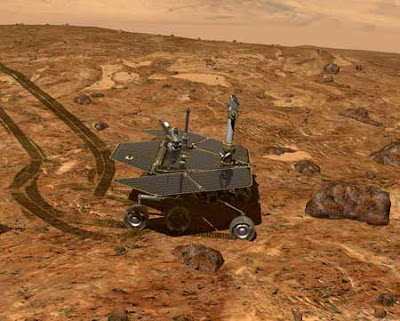By Xinhua,
Washington : Five years ago, NASA’s rover Spirit landed safely on Mars, followed by its twin, Opportunity, three weeks later. Though it was hoped the rovers would work for three months, the duo may still have big achievements ahead as they reach the fifth anniversary of their memorable landings.
Of the hundreds of engineers and scientists who cheered at NASA’s Jet Propulsion Laboratory (JPL) in Pasadena, California, on Jan. 3, 2004, none predicted the team would still be operating both rovers in 2009.

Six-wheeled rover
“The American taxpayer was told three months for each rover was the prime mission plan,” said Ed Weiler, associate administrator for NASA’s Science Mission Directorate. “The twins have worked almost 20 times that long. That’s an extraordinary return of investment in these challenging budgetary times.”
The rovers have made important discoveries about wet and violent environments on ancient Mars. They also have returned a quarter-million images, driven more than 21 kilometers, climbed a mountain, descended into craters, struggled with sand traps and aging hardware, survived dust storms, and relayed more than 36 gigabytes of data via NASA’s Mars Odyssey orbiter. To date, the rovers remain operational for new campaigns the team has planned.
“These rovers are incredibly resilient considering the extreme environment the hardware experiences every day,” said John Callas, JPL project manager for Spirit and Opportunity. “We realize that a major rover component on either vehicle could fail at any time and end a mission with no advance notice, but on the other hand, we could accomplish the equivalent duration of four more prime missions on each rover in the year ahead.”
Occasional cleaning of dust from the rovers’ solar panels by Martian wind has provided unanticipated aid to the vehicles’ longevity. However, it is unreliable aid. Spirit has not had a good cleaning for more than 18 months. Dust-coated solar panels barely provided enough power for the rover to survive its third southern-hemisphere winter, which ended in December.
“This last winter was a squeaker for Spirit,” Callas said. “We just made it through.”
With Spirit’s energy rising for spring and summer, the team plans to drive the rover to a pair of destinations about 183 meters south of the site where Spirit spent most of 2008.
One of the destinations is a mound that might yield support for a theory that a plateau Spirit has studied since 2006, called Home Plate, is a remnant of a once more-extensive sheet of explosive volcanic material. The other destination is a house-size pit called Goddard.
“Goddard doesn’t look like an impact crater,” said Steve Squyres of Cornell University, who is the principal investigator for the rover science instruments. “We suspect it might be a volcanic explosion crater, and that’s something we haven’t seen before.”
A light-toned ring around the inside of the pit might add information about a nearby patch of bright, silica-rich soil that Squyres considers Spirit’s most important discovery so far.
Spirit churned up the silica in mid-2007 with an immobile wheel that the rover has dragged like an anchor since it quit working in2006. The silica was likely produced in an environment of hot springs or steam vents.
For Opportunity, the next major destination is Endeavour Crater. Endeavor is approximately 22 kilometers in diameter, more than 20 times larger than another impact crater, Victoria, where Opportunity spent most of the past two years.
Since climbing out of Victoria four months ago, Opportunity has driven more than a mile toward Endeavour and has inspected the first of several rocks the team plans to examine along the way.
High-resolution images from NASA’s Mars Reconnaissance Orbiter, which reached the planet in 2006, are helping the team plot routes around potential sand traps that previously were not discernible from orbit.
“We keep setting the bar higher for what these rovers can do,” said Frank Hartman, a JPL rover driver. “Once it seemed like a crazy idea to go to Endeavour but now we’re doing it.”
“The journeys have been motivated by science but have led to something else important,” Squyres said.
“This has turned into humanity’s first overland expedition on another planet. When people look back on this period of Mars exploration decades from now, Spirit and Opportunity may be considered most significant not for the science they accomplished but for the first time we truly went exploring across the surface of Mars,” Squyres said.

